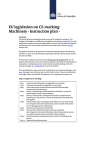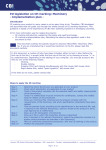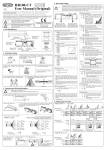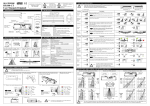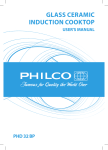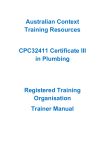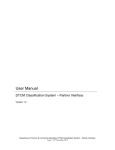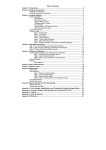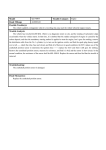Download EU legislation on CE-marking: Low Voltage Equipment
Transcript
EU legislation on CE-marking: Low Voltage Equipment - Instruction plan Summary This file will guide you through the whole process of CE marking for low voltage equipment. This guidance is based on the experiences of CBI when assisting exporters in developing countries. This document outlines the specific issues for Directive 2006/95/EC. This is the new numbering of directive 73/23/EEC: Low Voltage Equipment as amended by 93/68/EEC. The Low Voltage Directive (LVD) 2006/95/EC seeks to ensure that electrical equipment within certain voltage limits both provides a high level of protection for European citizens and enjoys a Single Market in the European Union. The Directive covers electrical equipment designed for use with a voltage rating of between 50 and 1000 V for alternating current and between 75 and 1500 V for direct current. It should be noted that these voltage ratings refer to the voltage of the electrical input or output, not to voltages that may appear inside the equipment. For most electrical equipment, the health aspects of emissions of Electromagnetic Fields are also under the domain of the Low Voltage Directive. The LVD is one of the oldest Single Market Directives and was written before the introduction of the "New" or "Global" Approaches to such legislation. However, in broad terms, it does characterize both by providing a conformity assessment procedure to be applied to equipment before being placed on the Market and Essential Health and Safety Requirements (EHSRs) which such equipment must meet either directly or by means of harmonized standards. For electrical equipment within its scope, the Directive provides the Requirements with respect to health and safety covering all risks, thus ensuring that electrical equipment is safe in its intended use. Guidelines on application and Recommendations are available including LVD ADCO documents and Recommendations - as well as European Commission opinions within framework of the Directive. This directive has not been changed recently, apart from the numbering. The information has undergone editorial changes only. Steps to apply the CE-marking Step 1 Step 2 Step 3 Step 4 Step 5 Determine which Directive(s) are applicable to your product Check which standard(s) are applicable to your product Check if the product complies with the essential health and safety requirements of the Directive(s) Check if a notified body must be involved for certification, contact the notified body for details on the procedures Draw up a Technical File, showing how the product complies with the requirements of the Directives, and which specifications (standards) have been applied Step 6 Test the product (type) according to the specifications in the technical file, and, if required in the relevant Directive(s), submit a model of the product to an EC type approval by a notified body Step 7 Draw up an EC Declaration of Conformity Step 8 Draw up a file in which the production process is described and, if required in the relevant Directive(s), submit the production process to a quality control procedure as describes in the Directive(s) Step 9 After all conformity assessment procedures: affix the CE-marking to the product Step 10 Monitor the production process EU legislation on CE-marking: Low Voltage Equipment – Instruction plan Step 1 - Determine which Directive(s) are applicable to your product Find out which Directive applies to your product. This is done by looking at the scope of the Directive, which is described in its text. Please note that more than one Directive might be applicable to your product. 1.1 The Low Voltage Equipment Directive This Directive seeks to ensure that electrical equipment within certain voltage limits both provides a high level of protection for European citizens and free market access to the EU. For electrical equipment within its scope, the Directive provides the requirements with respect to health and safety covering all risks, thus ensuring that electrical equipment is safe in its intended use. For the text of the Directive, click here. Please note that step 1 requires investigation whether other Directives might be applicable as well. Some products may be subject to more than one Directive. For example, for electrical machinery the Machinery Directive, the Low Voltage Directive (LVD) and the Directive on Electromagnetic Compatibility (EMC) are also applicable. If the electrical equipment consists of, or contains pressure equipment, the Pressure Equipment Directive (PED) may be relevant. See the separate documents on the various Directives mentioned. To establish the relevance of the other Directives, see step 1 in each of the Directives described. Please note that each definition is known for its exceptions. Thus, the simultaneous application in two different Directives may also be excluded. For example, if the risks of electrical equipment are mainly of electrical origin (e.g. electrical shock, short circuit), the Machinery Directive is not relevant, since the risks are covered by the LVD (and the EMC Directive). Directives that possibly apply as well Directive 98/37/EEC 2004/108/EC (as amended) 97/23/EC (as amended) Title Machinery Electromagnetic Compatibility Abbreviation MD EMC Pressure Equipment PED Please note that a full list of Directives is shown in the related document CE marking instruction plan. This includes a table with arrows, which are links to websites showing Directives, information about Directives, development of standards, and a list of harmonised standards in relation to the Directive concerned. The European Commission provides guidance on internet on how to apply the Low Voltage Directive. Click on Guidelines on the application of Directive 2006/95/EC for additional information and note specifically chapter VI on the specific relations with other Directives. 1.2 Scope of the Directive (electrical equipment) The Directive on Low Voltage covers electrical equipment designed for use with a voltage rating between 50 and 1000 V for alternating current and between 75 and 1500 V for direct current. These voltage ratings refer to the voltage of the electrical input or output, not to voltages that may appear inside the equipment. EU legislation on CE-marking: Low Voltage Equipment – Instruction plan Battery operated equipment outside the voltage rating is obviously outside the scope of the LVD. Nevertheless, the accompanying battery-charger as well as equipment with integrated power supply unit within the voltage ranges of the Directive are within the scope of the LVD. This applies also, in the case of battery-operated equipment with supply voltage rating under 50 V AC and 75 V DC, for their accompanying power supply unit (e.g. notebooks). However, the following equipment is excluded from the scope of the Low Voltage Directive, since they are covered by other Community Directives: Electrical equipment for use in a potentially explosive atmosphere Electrical equipment for radiology and medical purposes Electrical parts for lifts Electricity meters. The following equipment is excluded from the scope of the Low Voltage Directive, since they are not covered by any Community Directive (so far) and therefore may not be CE marked: Plugs and socket outlets for domestic use Electric fence controllers Specialised electrical equipment, for use on ships, aircraft or railways which complies with the safety provisions drawn up by international bodies in which the Member States participate. Broadly, the Directive covers consumer and capital goods designed to operate within the abovementioned voltage limits, including in particular electrical appliances, lighting equipment including ballasts, switch gear and control gear, electric wiring, appliance couplers and cord sets, electrical installation equipment, cable management systems etc. 1.3 Scope of the Directive (components) The scope of the Directive includes both electrical equipment intended for incorporation into other equipment and equipment intended to be used directly without being incorporated. Some types of electrical devices are designed and manufactured for being used as basic components to be incorporated into other electrical equipment. Their safety largely depends on how they are integrated into the final product and the overall characteristics of the final product. These basic components are not covered as such by the Directive. In particular, they must not be CE marked. Please note that in practice your buyer might request CE marking for your basic components. According to the Directive this is not justified. It is not allowed by EU legislation to CE mark a product that is excluded by the Directive. However, other electrical components which are intended for being incorporated into other electrical equipment, but for which a safety assessment is feasible like - for example some types of transformers and electrical motors, are covered as such by the Directive and must be CE marked. Moreover, the scope of the exclusion of basic components must not be misunderstood and extended to items like lamps, starters, fuses, switches for household use, elements of electrical installations, etc., which, even if they are often used in conjunction with other electrical equipment and have to be properly installed in order to deliver their useful function, are themselves to be considered electrical equipment in the sense of the Directive. EU legislation on CE-marking: Low Voltage Equipment – Instruction plan Step 2 - Check which standard(s) are applicable to your product For compliance with the Directives that apply to your product, standards give detailed technical information on implementing the EU requirements. However, not all standards have been harmonised yet. Only standards that have their reference published in the Official Journal of the EU are called ‘harmonised standards’. Complying with these standards means that the authorities presume compliance with the Directives. This step of checking the relevant standards – whether or not harmonised – is crucial for CE-marking. 2.1 How to find harmonised standards The EU is in the process of harmonising the standards that are used in all the individual EU countries. It is recommended to look for the applicable harmonised standards. A list of harmonized standards can be found here. However, not all standards are harmonised yet. 2.2 Other standards and draft standards Many more standards are under development. There are various standardization activities in the field of the Low Voltage Directive. They are listed at the following site, click here. Step 3 - Check if the product complies with the essential health and safety requirements of the Directive Apply the relevant standards for the performance requirements in the Directives or the technical verification, and, where appropriate, a risk assessment. The Low Voltage Directive covers all risks arising from the use of electrical equipment, including not just electrical ones but also mechanical, chemical (such as, in particular, emission of hazardous substances) and all other risks. The Directive also covers health aspects of noise and vibrations, and ergonomic aspects as far as ergonomic requirements are necessary to protect against hazards in the sense of the Directive. 3.1 Safety objectives of the Low Voltage Directive Article 2 and Annex I of the Directive lay down eleven "safety objectives", which represent the essential requirements of this Directive. The objects are divided into general conditions, protection against firstly hazards arising from the electrical equipment and secondly hazards which may be caused by external influences. General conditions The essential characteristics, the recognition and observance of which will ensure that electrical equipment will be used safely and in applications for which it was made, shall be marked on the equipment, or, if this is not possible, on an accompanying notice. The manufacturer’s brand name or trademark should be clearly printed on the electrical equipment or, where that is not possible, on the packaging. The electrical equipment, together with its component parts should be made in such a way as to ensure that it can be safely and properly assembled and connected. The electrical equipment should be so designed and manufactured as to ensure that protection against the hazards set out in points 2 and 3 above is assured providing that the equipment is used in applications for which it was made and is adequately maintained. Protection against hazards arising from the electrical equipment EU legislation on CE-marking: Low Voltage Equipment – Instruction plan Measures of a technical nature should be prescribed in accordance with the abovementioned requirements, in order to ensure: That persons and domestic animals are adequately protected against danger of physical injury or other harm which might be caused by electrical contact direct or indirect; That temperatures, arcs or radiation which would cause a danger, are not produced; That persons, domestic animals and property are adequately protected against nonelectrical dangers caused by the electrical equipment which are revealed by experience; That the insulation must be suitable for foreseeable conditions. Protection against hazards which may be caused by external influences on the electrical equipment Technical measures are to be laid down in accordance with the requirements mentioned at the general conditions, in order to ensure: That the electrical equipment meets the expected mechanical requirements in such a way that persons, domestic animals and property are not endangered; That the electrical equipment shall be resistant to non-mechanical influences in expected environmental conditions, in such a way that persons, domestic animals and property are not endangered; That the electrical equipment shall not endanger persons, domestic animals and property in foreseeable conditions of overload. Please note that electromagnetic compatibility aspects (emission and immunity) are excluded from the scope of this Directive and are separately regulated under the EMC Directive. Please note that radiation aspects referred to in the list above, are limited to those directly relevant for health and safety of persons and domestic animals, and do not cover electromagnetic disturbances in the sense of the EMC Directive. Step 4 - Check if a notified body must be involved for certification Contact a notified body, if required or desired, for details on the procedures. A notified body is not required for products covered by the Low Voltage Directive. However, if the product must comply with other directives as well, the applicability of the other directives may involve the obligation to involve a notified body in the conformity assessment. It depends on the Directive(s) involved if a notified body must be involved for certification of the product and the production process. Click here for a list of notified bodies. Please note that 10 practical tips on how to select a notified body are given in the basic document explaining the steps. See the related document on the CE marking instruction plan. Step 5 - Draw up a Technical File, showing how the product complies with the requirements of the Directives, and which specifications (standards) have been applied EU legislation on CE-marking: Low Voltage Equipment – Instruction plan The technical file should contain the documentation on how the conformity has been achieved. If the Directive requires a verification of the file, for example when the product has to be submitted to an EC type approval, this file will be checked together with the product or separately. Besides general information like name and address of the manufacturer, identification of the product, drawings and overviews of the product, all relevant detailed information on the design, construction and testing, risk assessment, certificates, applied standards, a description of the preventive measures and a copy of the user manual must be included. Where no standards within the meaning of the Directive have been applied, the manufacturer has to provide within the technical documentation a description of the solutions adopted to satisfy the safety requirements of the Directive. Technical documentation must enable the conformity of the electrical equipment to the requirements of this Directive to be assessed. It must, as far as relevant for such assessment, cover the design, manufacture, and operation of the electrical equipment. It must include details of the design, manufacture and operation of the electrical equipment in so far as these details are needed to assess the conformity of the electrical equipment with the requirements of the Directive. Accordingly, it contains: A general description of the electrical equipment, Design and manufacturing drawings and schemes of components, sub-assemblies, circuits, etc., Descriptions and explanations necessary for the understanding of said drawings and schemes and the operation of the electrical equipment, A list of the standards applied in full or in part, and descriptions of the solutions adopted to satisfy the safety aspects of this Directive where standards have not been applied, Results of design calculations made, examinations carried out, etc., Test reports (in fact, the test reports which may be available, either established by the manufacturer or a third party). The manufacturer or his authorized representative must keep a copy of the declaration of conformity with the technical documentation. The technical documentation must be kept at the disposal of the national authorities for inspection purposes for at least ten years from the last date of manufacture of the product. The documentation may be kept on electronic support, provided that it is easily accessible for inspection. Where the manufacturer is not established in the EU and he has no authorized representative in the Community, this obligation lies with the importer or the person responsible for placing the product on the Community market. Please note that the technical documentation must be kept within the EU. Step 6 – Test the product (type) according to the specifications in the technical file, and, if required in the relevant Directive(s), submit a model of the product to an EC type approval by a notified body EU legislation on CE-marking: Low Voltage Equipment – Instruction plan All testing carried out by the manufacturer, a laboratory, test house or notified body, will be included in the technical file. Since it is not always possible or feasible to test onsite, the technical file may be completed as far as the description of the product and the (intended) compliance with the relevant Directives and standards. In respect of conformity assessment, there is no third party intervention, as the manufacturer undertakes the conformity assessment by himself, a so-called selfassessment. This involves testing before self-certification. Notified body testing is not compulsory, but may be used as a marketing tool or to prevent “challenges” by market surveillance authorities. Click here to find out which notified bodies are available to do Low Voltage Equipment testing. In case of challenge by the authorities in charge of market surveillance, a report from the notified body is considered an element of proof (Directive 73/23/EEC, Article 8(2)). This report may provide, in the event that conformity is doubted, a submission to the market surveillance authorities of a report drawn up by a notified body as evidence that the electrical equipment complies with the safety objectives (Article 2 and Annex I, see step 3). The manufacturer or his authorized representative established in the EU may wish to ask in advance for a report to be drawn up by a notified body and to keep it together with the technical documentation. The availability of such a report would facilitate the process of conformity assessment in case of doubt. The EU designed flow charts for all Directives with the process of the conformity assessment. You can find the flow chart for the LVD in Annex A of this document. Click ( Flow Chart). It is recommended to print this flow chart. Please note The flow chart refers to directive 73/23/EEC. The new directive 2006/95/EC is identical. Only the number has been changed. Step 7 – Draw up an EC Declaration of Conformity With the EC Declaration of Conformity, the manufacturer officially declares that the product complies with essential requirement of the applicable Directives. The manufacturer also declares that, if this product has been submitted to an EC type approval, each product is in conformity with the model that has been approved. The EC declaration of conformity (Annex III, (B) must contain the following elements: Name and address of the manufacturer or his authorized representative established within the Community, A description of the electrical equipment, Reference to the harmonized standards, Where appropriate, references to the specifications with which conformity is declared, Identification of the signatory who has been empowered to enter into commitments on behalf of the manufacturer or his authorized representative established within the Community, The last two digits of the year in which the CE marking was affixed. Step 8 – Draw up a file in which the production process is described, and, if required in the relevant Directive(s), submit the production process to a quality control procedure as describes in the Directive(s) EU legislation on CE-marking: Low Voltage Equipment – Instruction plan To ensure that each product will be the same as the model that has been approved, the production process must be described. For many Directives, this is an obligation. The production process must be described in the Low Voltage Directive. This obligation is described in Annex IV of the Low Voltage Directive to ensure that each product will be the same as the type that has been approved. The obligation is called internal production control. Internal production control is the procedure that the manufacturer (or his authorized representative established within the EU) gives a written guarantee that the electrical equipment is in accordance with the Directive. Thus, he must affix the CE marking to each product (see step 8) and draw up a declaration of conformity (see step 6). The manufacturer must take all measures within the manufacturing process to ensure compliance with the technical documentation (see step 4) and with the requirements of the Low Voltage Directive. Step 9 - Affix the CE marking Finally, the CE marking has to be affixed to the product. It must be clearly readable and irremovable attached to the product. Besides the CE marking, the name and address, serial or type indication, as well as the production year of the product have to be mentioned on the product. The CE conformity marking (Annex III, (A) shall consist of the initials ‘CE' taking the following form: If the CE marking is reduced or enlarged the proportions given in the below graduated drawing must be respected. The various components of the CE marking must have substantially the same vertical dimension, which may not be less than 5 mm. Step 10 - Monitor the production process, the development of legislation and standards After affixing the CE marking, make sure that the conformity is maintained. The declaration of conformity becomes void if alterations to the type are made. Some alterations may be very small. Still, it is important to put these alterations into a file. EU legislation on CE-marking: Low Voltage Equipment – Instruction plan New and revised standards do not influence the validity of the CE marking and the EC Declaration of Conformity as long as the product type does not change. Last updated: June 2009 EU legislation on CE-marking: Low Voltage Equipment – Instruction plan Annex A Flow chart Click ( back to the text)










